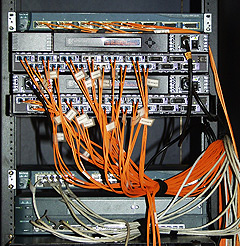Glossary
POP: Short for Post Office Protocol, a protocol used to retrieve e-mail from a mail server. Most e-mail applications (sometimes called an e-mail client) use the POP protocol, although some can use the newer IMAP (Internet Message Access Protocol).
There are two versions of POP. The first, called POP2, became a standard in the mid-80's and requires SMTP to send messages. The newer version, POP3, can be used with or without SMTP.
POP: Short for point of presence, an access point to the Internet. ISPs have typically multiple POPs. A point of presence is a physical location, either part of the facilities of a telecommunications provider that the ISP rents or a separate location from the telecommunications provider, that houses servers, routers, ATM switches and digital/analog call aggregators.
SMTP: (pronounced as separate letters) short for Simple Mail Transfer Protocol, a protocol for sending e-mail messages between servers. Most e-mail systems that send mail over the Internet use SMTP to send messages from one server to another; the messages can then be retrieved with an e-mail client using either POP or IMAP. In addition, SMTP is generally used to send messages from a mail client to a mail server. This is why you need to specify both the POP or IMAP server and the SMTP server when you configure your e-mail application.
Email Client is an application - a computer program - used to send, receive and view e-mail. Some common examples include Outlook, Outlook Express, Eudora, Firefox, GoldMine etc. This is different from an e-mail server, such as mail.siriustechnology.comAn application that controls the distribution and storage of e-mail messages.
Email Server is an application that controls the distribution and storage of e-mail messages.
Spam is a form of an electronic junk mail or junk newsgroup postings. Some people define spam even more generally as any unsolicited e-mail containing an advertising for some product sent to a mailing list or newsgroup.
In addition to wasting people's time with unwanted e-mail, spam also uses up a lot of network bandwidth. Consequently, there are many organizations, as well as individuals, who have taken it upon themselves to fight spam with a variety of techniques. But because the Internet is public, there is really little that can be done to prevent spam, just as it is impossible to prevent junk mail. However, some online services have instituted policies to prevent spammers from spamming their subscribers.
There is some debate about the source of the term, but the generally accepted version is that it comes from the Monty Python song, "Spam spam spam spam, spam spam spam spam, lovely spam, wonderful spam…" Like the song, spam is an endless repetition of worthless text. Another school of thought maintains that it comes from the computer group lab at the University of Southern California who gave it the name because it has many of the same characteristics as the lunchmeat Spam:
Nobody wants it or ever asks for it.
No one ever eats it; it is the first item to be pushed to the side
when eating the entree.
Sometimes it is actually tasty, like 1% of junk mail that is really
useful to some people.
An electronic boundary (or physical piece of hardware) that prevents unauthorized users and/or packets of data or information (e.g., files and programs) from accessing a protected system.
DNS: Short for Domain Name System (or Service or Server), an Internet service that translates domain names into IP addresses. The Internet is really based on IP addresses, so every time you use a domain name, a DNS service must translate the name into the corresponding IP address. For example, the domain name www.powersolution.com translates to 216.251.43.17.
The DNS system is, in fact, its own network. If one DNS server doesn't know how to translate a particular domain name, it asks another one, and so on, until the correct IP address is returned.
In most simplest terms, DNS record is a way for the internet browser to identify the location where you website is hosted for tasks such as geting the files for your website and to send an email addressed to you.
Domain Name Registrar is an organization that manages Internet domain names. Any person or company that wants a presence on the Internet must register a unique name with one of the many registrars, such as Network Solutions (www.netsol.com) or Go Daddy (www.godaddy.com) among others.
